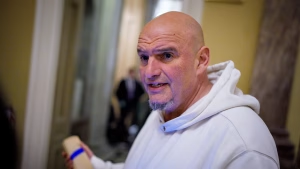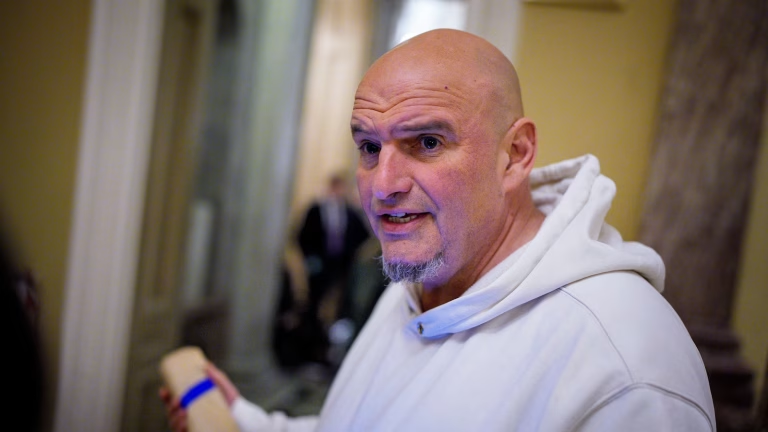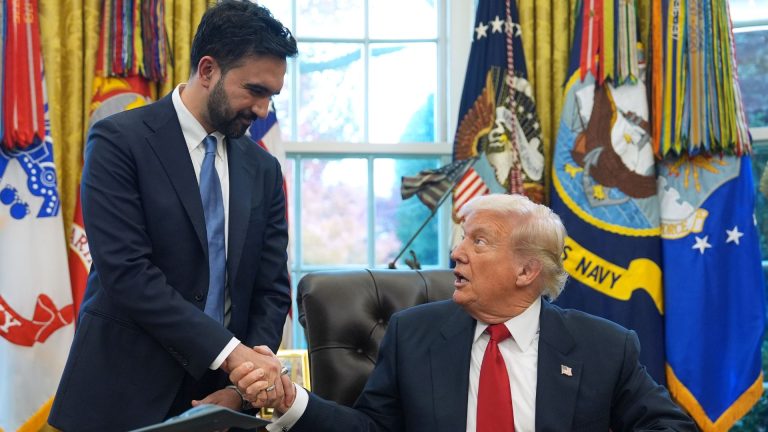In a carefully orchestrated display of diplomacy and style, the United States welcomed Saudi Arabia’s Crown Prince Mohammed bin Salman to Washington D.C. this week for a series of meetings and events designed to strengthen bilateral relations. The visit included high-level discussions on defense, investment, and technological cooperation, culminating in a black-tie state dinner attended by a mix of global political and business figures.
The meetings underscored the United States’ ongoing commitment to its strategic partnership with Saudi Arabia. President Donald Trump formally described the kingdom as a “major non-NATO ally,” granting access to advanced military equipment as part of a broader defense collaboration. During an Oval Office discussion, Trump highlighted the kingdom’s purported advancements in human rights, praising the Crown Prince for strides made in reform initiatives.
Among the initiatives announced was a significant arms deal, with plans for advanced F-35 fighter jets to be sold to Saudi Arabia. The agreement followed major investment pledges from the kingdom in emerging U.S. industries, including artificial intelligence, civil nuclear energy, and other technological sectors. These developments reflect the ongoing effort to solidify economic and defense ties while reinforcing the strategic partnership between the two nations.
While the policy discussions dominated headlines, attention also turned to the ceremonial elements of the visit, particularly the state dinner. The black-tie event, held on Tuesday evening, drew prominent figures from sports, technology, and business, including Cristiano Ronaldo, currently playing for Saudi Pro League team Al-Nassr, and tech leaders such as Elon Musk and Tim Cook. The gathering underscored the interplay between international diplomacy, cultural symbolism, and soft power.
One of the most discussed elements of the evening was a subtle yet pointed diplomatic gesture made through fashion. First Lady Melania Trump drew attention with her choice of a strapless emerald-green gown, a color widely recognized as a symbol associated with Saudi Arabia. The gown, designed by Elie Saab and reported to cost $3,350, featured a ruched design at the midsection with a tasteful slit at the front, combining elegance with a statement of intentionality.
Observers and social media users quickly noted the parallels between the color of the gown and the Saudi national flag, which prominently features a green field representing peace and Islamic heritage. Many also pointed out that the design echoed elements of the kingdom’s emblem, which includes a palm tree and two crossed swords—symbols of generosity, hospitality, and resilience. The dress, therefore, was interpreted by some as a deliberate nod to the Crown Prince and the broader Saudi cultural identity, reflecting an awareness of the ceremonial significance of such diplomatic gestures.
Public reactions to the gown were overwhelmingly positive, with numerous commentators praising the First Lady for blending style and diplomacy. On social media, users highlighted the visual alignment of the outfit with Saudi national symbols, with one Twitter user writing: “The First Lady @melaniatrump chose a beautiful green dress in the exact same shade as the Saudi flag, which stands for peace, and its design also matches the Kingdom’s emblem, the palm tree, which represents generosity and hospitality. Such a nice and respectful tribute to the Kingdom.” Others focused on the aesthetic and elegance of the choice, noting that it exemplified how fashion can serve as a subtle but effective form of soft diplomacy.
This interpretation aligns with a broader understanding of how ceremonial attire can reinforce diplomatic messaging. Throughout history, political leaders and their spouses have used clothing to communicate respect, alliance, and awareness of cultural context during high-profile international engagements. In this instance, the First Lady’s gown became a visual bridge, complementing the official discussions and signaling attentiveness to the cultural and symbolic dimensions of the visit.
The state dinner itself followed a full day of official meetings in the White House. President Trump and the Crown Prince engaged in discussions covering a range of economic and strategic topics. Among the central themes was the ongoing partnership on defense and security, with a focus on modernizing military hardware and technology exchange. These conversations are part of a longer-term effort to solidify the alliance and ensure that both nations are positioned for cooperative engagement in the Middle East.
Beyond the official agenda, the event also reflected the integration of political, economic, and social elements in contemporary diplomacy. Attendees represented multiple spheres of influence—from high-ranking politicians and former officials to business leaders and internationally recognized sports figures. Such gatherings underscore how modern diplomacy increasingly blends policy discussion with public relations and soft power projection.
Fashion, in this context, operates as a subtle yet powerful channel of communication. By choosing a gown that resonated visually with the host nation’s national symbols, the First Lady contributed to a broader narrative of mutual respect and cultural awareness. The visual cues served not only to honor the visiting dignitary but also to reinforce the United States’ commitment to understanding and acknowledging the traditions and values of its partners.
Melania Trump has a history of using fashion strategically during international engagements. From carefully selected color palettes to dresses and accessories that echo cultural or historical motifs, her choices often carry symbolic weight beyond aesthetic considerations. This particular emerald-green gown fits squarely within that pattern, demonstrating a nuanced understanding of how visual symbolism can complement formal diplomatic proceedings.
While the gown received substantial attention online, the broader context of the evening also merits focus. Discussions of military cooperation, investment, and economic development illustrate the multifaceted nature of modern state visits, where symbolism and substance intersect. The arms deals, technology investments, and strategic conversations all contribute to shaping the United States’ foreign policy priorities, while ceremonial gestures underscore a broader narrative of cultural respect and partnership.
Observers have noted that such gestures, while subtle, can have a measurable impact on diplomatic relations. A carefully chosen outfit can send messages of goodwill, attentiveness, and sensitivity to cultural expectations—qualities that are often appreciated by host nations and can facilitate smoother negotiations. The First Lady’s gown exemplified this principle, with its design and color choices reinforcing themes of respect and mutual recognition between the United States and Saudi Arabia.
Public response to the state dinner and the First Lady’s fashion choice reflected the interplay between international diplomacy and social media in shaping perceptions. Commentators on platforms such as Twitter and Instagram celebrated the combination of elegance and diplomacy, noting the careful attention to symbolic detail. Users emphasized that such gestures, though subtle, enhance the overall atmosphere of respect and collaboration during high-profile state visits.
The evening also highlighted the broader role of ceremonial events in modern governance. Beyond formal discussions and press releases, state dinners and public gatherings provide an opportunity for leaders to demonstrate attentiveness to cultural context, build personal rapport, and convey messages through both words and actions. Attire, seating arrangements, and even the timing of public interactions can all contribute to the impression made on visiting dignitaries.
In addition to the symbolic significance of the gown, the First Lady’s presence at the dinner underscored the broader role of spouses in diplomatic relations. While not always involved in policy discussions, spouses can serve as cultural ambassadors, conveying respect, elegance, and attentiveness to symbolic norms. This dynamic enhances the overall experience of visiting officials and contributes to the narrative of partnership and mutual understanding.
The event also demonstrated the United States’ ongoing commitment to strengthening ties in the Middle East, particularly with nations like Saudi Arabia, which play strategic roles in regional stability, energy markets, and economic development. By combining high-level policy discussions with ceremonial diplomacy, the administration signaled both its seriousness in negotiations and its attentiveness to the softer dimensions of international relations.
In conclusion, the state dinner with Saudi Crown Prince Mohammed bin Salman served multiple purposes: advancing policy objectives, solidifying economic and defense partnerships, and showcasing the power of symbolic diplomacy. Melania Trump’s choice of an emerald-green gown exemplified how visual elements can complement official proceedings, creating an atmosphere of respect and attentiveness that transcends words. Public reactions have highlighted the effectiveness of such subtle gestures, emphasizing that in high-stakes diplomacy, every detail—whether in conversation, seating, or attire—can contribute to the narrative and tone of the visit.
The successful integration of ceremonial elegance and policy discussions underscores the complexity of modern diplomacy, where symbolism and substance are intertwined. By acknowledging and incorporating elements of the host nation’s culture into public appearances, leaders and their spouses can reinforce messages of partnership, mutual respect, and cultural awareness. The First Lady’s gown, closely aligned with the Saudi national color and emblematic motifs, represents a clear example of this principle in practice.
As global attention continues to follow the outcomes of this visit, the interplay of style, diplomacy, and strategic policy offers valuable insights into how leaders communicate both directly and indirectly with their counterparts. In this instance, the combination of substantive agreements and symbolic gestures, epitomized by the First Lady’s wardrobe choice, illustrated the multidimensional nature of diplomacy in the 21st century. It serves as a reminder that in international relations, subtlety and attentiveness often carry as much weight as formal policy pronouncements.

Emily Johnson is a critically acclaimed essayist and novelist known for her thought-provoking works centered on feminism, women’s rights, and modern relationships. Born and raised in Portland, Oregon, Emily grew up with a deep love of books, often spending her afternoons at her local library. She went on to study literature and gender studies at UCLA, where she became deeply involved in activism and began publishing essays in campus journals. Her debut essay collection, Voices Unbound, struck a chord with readers nationwide for its fearless exploration of gender dynamics, identity, and the challenges faced by women in contemporary society. Emily later transitioned into fiction, writing novels that balance compelling storytelling with social commentary. Her protagonists are often strong, multidimensional women navigating love, ambition, and the struggles of everyday life, making her a favorite among readers who crave authentic, relatable narratives. Critics praise her ability to merge personal intimacy with universal themes. Off the page, Emily is an advocate for women in publishing, leading workshops that encourage young female writers to embrace their voices. She lives in Seattle with her partner and two rescue cats, where she continues to write, teach, and inspire a new generation of storytellers.









